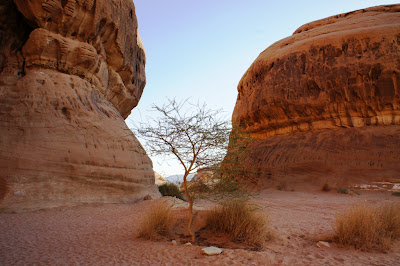Saudi's National Day (today) gave us a long week-end and the opportunity for us to finally take a trip to Mada'in Saleh, the main archeological site in the country, listed by the UNESCO as a World Heritage Site, located in the province of Al-Madinah.
We flew to Yanbu', where we visited Richard's brother as well as a couple of friends who used to live in Jubail and recently moved to Yanbu' (and they never liked Jubail as much as the day they discovered Yanbu'!). From Yanbu', it's a 4-hour drive to the town of Al-'Ula, which is quite a long drive, especially since the road is not very wide, and you have to drive through a couple of towns, each welcoming you with some nice speed bumps which are not even painted so that if, like us, you're in the hands of a Bangladeshi driver who's only half awake, you're guaranteed to be in for a rough trip!
Al-'Ula is quite small, but it has a reasonably nice hotel where most tourists stay, and which also arranges permits to visit Mada'in Saleh (issued by the Commission for Tourism and Antiquities in Riyadh) as well as guided tours. In spite of the recent events, and the subsequent fear of travelling in Muslim countries for many Westerners, there were quite many tourists that day: a large group of Japanese, another group of French and some foreign students from China, Mexico, Germany and the US studying at the KAU University in Jeddah.
We went to Mada'in Saleh (23 km from Al-'Ula) with Saïd, our Saudi guide. Mada'in Saleh was the Nabataeans' (the people who carved the city of Petra in Jordan) second city. It is also believed to have been inhabited by the tribe of Thamud as early as in the 3rd millenium BC, while the Nabataeans settled there in the 1st century CE. The archeological site is home to 131 tombs carved out of the sandstone outcrops, their size and style depending on the status of their owners.
 |
| In the surroundings of Al-'Ula |
 |
| Elephant rock, Al-'Ula |
 |
| Elephant rock, Al-'Ula |
 |
A tomb in Mada'in Saleh
The stairs at the top of the carving represent the stairs to Heaven |
 |
| The view from the top of an outcrop |
 |
| On the right, an unfinished tomb |
 |
| The eagle above the tomb's door represents a divinity taking the soul to Heaven |
 |
| The variety of the shapes of the outcrops lets imagination bloom. Here, a human profile on the right. |
 |
| A place where sheeps used to be sacrificed |
 |
| Ad-Diwan, a place for religious gatherings |
 |
| Rock paintings: monkeys |
 |
| Inside a tomb |
 |
| A tomb on top of an outcrop, probably that of someone important, for it is isolated and close to the sky. |

























